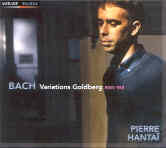Bach’s Goldberg Variations have played a central role in harpsichordist Pierre Hantai’s musical life since his early youth. At 28 he recorded the work for the Opus 111 label (now available on Naïve), a highly acclaimed release that stands among the work’s choice versions. Over the past 11 years Hantai evidently has rethought and refined his interpretation, as revealed in this 2003 remake. There’s greater rhythmic freedom and variety of articulation, plus a more subjective approach to ornaments and agogics, especially in the repeats (he observes all but those in Variation 15, 25, and the Aria Da Capo; the 1992 recording honors all repeats save for Variation 25). Variations previously characterized through Hantai’s seamless legato technique (Nos. 3, 6, 8, 11, 17, and 18, for example) are further enlivened by detaché finger strokes and more inflected phrasings. The latter infuse Variations 7, 10, and 16 with greater resilience and rhythmic verve than their earlier counterparts.
Hantai’s virtuosic ease in the two-keyboard variations reappears in lighter, more fluid manifestations. No. 20’s triplet runs, for instance, really let go and fly this time, and No. 11’s cross-handed lines interact with greater clarity. Similarly, Variations 26 and 28 are more crisply projected and playful. Hantai still spins No. 13’s right-hand cantilena in lovely, aria-like arcs, but the left hand now emerges as an equal partner rather than mere accompanist.
Yet some of Hantai’s interpretive revisions seem studied, even mannered, such as lingering on a variation’s first note, or starting a variation’s first measure slowly and gradually working up to tempo by the end (the French Overture’s first chord sounds disconnected from the flourish that follows). Variation 23’s twitchy adjustments throw the shape of the line slightly askew, in contrast to the earlier recording’s steadier gait. The same holds true for Variations 9 and 30, where Hantai’s stop-and-start phrase shaping lacks the first traversal’s continuity and flow.
Then there’s the question of instrument. Despite Hantai’s greater economy of registration this time around (fewer octave couplings), the Jonte Knif German model used for the present recording does not match the dulcet timbre and warm resonance of the Dutch Bruce Kennedy cembalo used in the Opus 111 recording. Compare Variation 14’s trills: here their strident, buzzsaw quality makes it difficult to ascertain the pitches, which was not the case earlier. These are minor considerations, however, in the face of the harpsichordist’s considerable virtues here. If Hantai’s Goldberg Variations remake does not necessarily supercede his previous recording, it nonetheless reflects his capacity for artistic growth and refusal to rest on his discographical laurels.
































